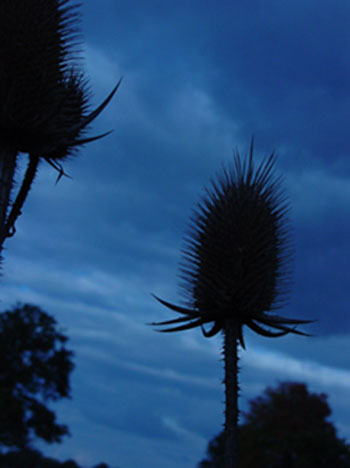| Invasive Plant Species |
 Most
invasive
plants are non-native or exotic plants. Invasive plants are
very aggressive and can move into an area and replace the
desirable vegetation that is occupying the area. The
desirable vegetation may be occupying a lawn, an
agricultural field, a roadside or natural area, no matter
the location, when an invasive plant enters an area and
becomes established, the invasive plant will disrupt the
plants that are growing in the area, and often totally
replace them. In the United States over 100 million acres of
land has been taken over by invasive plants and the annual
increase has been estimated to be 14%.
Most
invasive
plants are non-native or exotic plants. Invasive plants are
very aggressive and can move into an area and replace the
desirable vegetation that is occupying the area. The
desirable vegetation may be occupying a lawn, an
agricultural field, a roadside or natural area, no matter
the location, when an invasive plant enters an area and
becomes established, the invasive plant will disrupt the
plants that are growing in the area, and often totally
replace them. In the United States over 100 million acres of
land has been taken over by invasive plants and the annual
increase has been estimated to be 14%.Many plants that are invasive were brought to this country for a specific purpose. Around fifty percent were introduced by the horticulture industry for landscaping purposes. Others were brought here by immigrants to use as medicinals, as cooking herbs, for fiber or for food. Some were introduced by government agencies for purposes such as wildlife food, wildlife habitat and erosion control. Many other invasives were accidentally introduced.
Several factors contribute to the ability of invasive plants to out compete the native vegetation. A major factor is a lack of predators and pathogens for the introduced plant in the new location. Predators and pathogens normally would greatly limit the plants numbers, but are often not present in the plant’s new home. Other reasons that help to explain the success of invasives includes the following: many invasives leaf-out earlier than other plants, invasives have tremendous reproductive capacities, they have seeds that are dispersed easily, and their seeds persist in the soil seed bank for an extended period.
One of the most serious threats posed by invasives is destruction of natural areas. With so few natural areas remaining in this country, the control of invasive plants becomes especially critical. When an invasive plant establishes in a natural area it out competes the native vegetation for resources and soon lowers the plant species diversity. This reduction of plant diversity degrades the entire community. The second largest threat to native species in natural areas is invasives of all types. Only direct habitat destruction is a larger threat to native organisms.
Besides being an ecological threat, invasives also are a threat to the economy. A study conducted by Cornell University discovered that invasives (all types) cost the United States @ $120 billion dollars a year. Thirty-five billion dollars are spent on control of invasive plants. Control efforts for purple loosestrife (Lythrum salicaria) alone cost $45 million a year.
Illinois has taken steps to stop the spread of invasive plants and to prevent the introduction of new invasive plants. It has the “Exotic Weed Act” which makes it illegal to “buy, sell, offer for sale, distribute or plant seeds, plants or plant parts” of ten exotic weeds that are invasive in Illinois. Also, Illinois has established an “Illinois Invasive Plant Species Council”. The Council is composed of individuals from the landscaping and nursery industries, state agencies, academics and private organizations. The Council’s goal is to “minimize the adverse economic and ecological effect that invasive plants pose to the state of Illinois”.
For more information on invasive plants, go to the Invasive Species Database that is included on this website. This database was complied with information from several agencies/organizations. The database gives a variety of information about invasive plants such as why the plant was introduced and control measures. Also included are the criteria used by various agencies and organizations to determine that a plant is invasive.
Invasive Plant Species Data Base was compiled by Eastern Illinois University student, Marissa Jernegan.
 Illinois
Exotic Weed Act
Illinois
Exotic Weed Act Invasive
Plant Species
Invasive
Plant Species Native
Substitutes
Native
Substitutes Related
Links
Related
Links